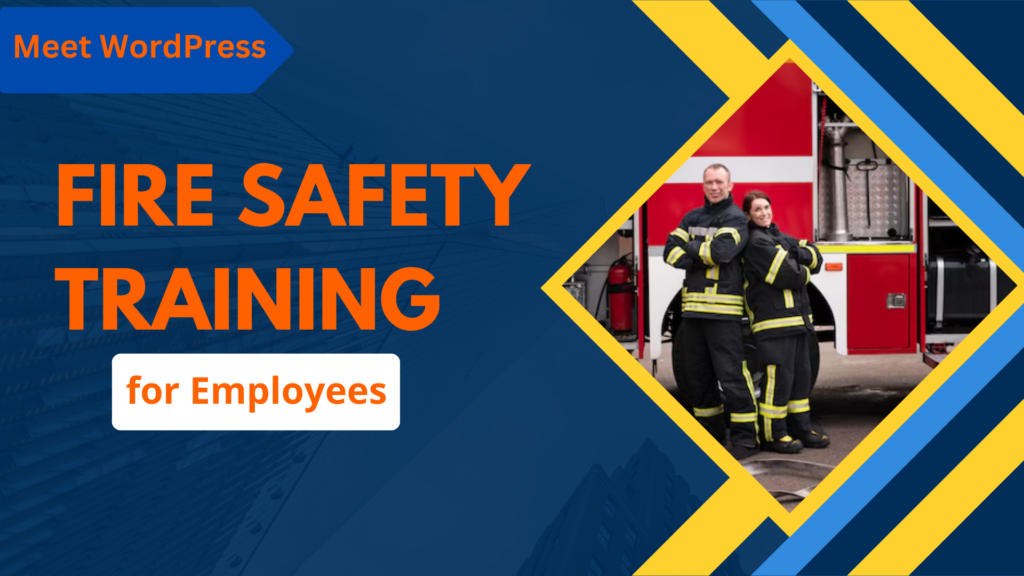Introduction
Fire safety training is among the most crucial elements of ensuring workplace safety. With the right training in place, panic can be lessened, employees can respond calmly and know they can take the right procedures to stay safe.
In this article, we’ll explore the importance of fire safety training, the essential topics it should include, and how to structure an effective training program for your workplace. Fire safety is more than just the right equipment – it’s having the proper knowledge and skills to respond properly when disaster strikes.
Fire Safety Training: A Matter of Life and Death
Saving Employees and Business Property
Fire safety training aims at protecting human beings and property. Fires spread quickly and can cause substantial damage to your office or workplace and even put employees at extremely high risk. With proper training, employees will know how to respond quickly during a fire, saving lives and reducing injuries. Knowing what to do in an emergency means reduced panic among employees and, ultimately, a safer situation for everyone involved.
Legal and Regulatory Compliance
It is the legal responsibility of employers to ensure that all employees have a safe working environment, and fire safety is a vital element of that. Fires kill more than 3300 people in Canada every year, and they are more precious than a life. Not providing this training can lead to legal consequences, such as fines and even shutting down a business. Besides meeting legal obligations, fire safety training reflects a business’s concern for staff, fostering employee morale and trust.

Ensuring a Safe Work Environment
Employee fire safety training also leads to a safer workplace in general. A safety-first workplace can keep a fire from even starting, decreasing the chances of a fire ever taking place.
Fire Safety Training: Key Topics to Cover
Workplace Fire Prevention
The best way to protect employees and investments is to prevent a fire before it occurs. Training on fire safety should include essential prevention tactics like.
Fire Emergency Procedures
Even with the best prevention methods, fires can occur. Employees need to know how to respond immediately and calmly should a fire break out. Fire safety training should include the following:
- When There Is a Fire: Employees should be trained on the immediate actions to take if a fire breaks out. These actions range from staying calm, evacuating the building, and notifying others of the danger. When people know what to do, confusion can be avoided, and everyone can remain safe.
- Evacuation Plans & Routes: Each place of employment should have a detailed evacuation plan in place. Workers must be aware of emergency exits, the safest routes to leave the building, and where to meet outside. Conducting evacuation drills will help employees exit quickly and safely.
Fire Drills and Evacuations
Regular fire drills help employees learn fire emergency procedures. They practice safe evacuation. They also learn to use fire extinguishers and respond to alarms. Fire drills conducted regularly should entail:
- Fire Drills: Employees need to carry out fire drills every six month minimum. Ensure everyone is aware of where to report, how to operate the emergency exits, and what to do in the event of a fire.
- Assign specific roles: Assign specific roles to employees during fire drills. For instance, one person could be responsible for assisting visitors in evacuating or another person could take on ensuring that all sections of the office are cleared out. These roles make sure everyone knows what to do for an actual emergency, and no one is left behind.
First Aid and Fire Safety
Additionally, fire safety training should include some basic first aid skills in case someone is injured in the fire. Employees should know:
- First Aid until Help Arrives: Employees should be able to assist injured co-workers and give comfort and support until first responders arrive. When necessary, employees must understand how to execute fundamental, life-saving moves.
Fire Safety Training Implementation Best Practices
Fire safety training needs to be specific to your environment, as every workplace is different. The risks in a warehouse will be different from a factory or an office, so it’s critical to customize the training to meet the needs of your workplace at a specific level.
Diverse Training Techniques
Everyone learns differently, which means different training methods will be needed to make sure everyone picks up the information. Consider using:
The best way to walk through and demonstrate is in person and to engage to answer questions. Employees can also practice using fire extinguishers and participate in live evacuation drills.
ABSENTEE online training: Online training can be a convenient tool for employees who are unable to attend in-person sessions. These programs may teach the theory of fire safety like how to spot hazards and comprehend fire safety protocols.
Printed materials: Give out fire safety handouts or posters that employees can reference during an emergency. These materials should review critical fire safety procedures and emergency contact numbers.

Involve All Employees
Conduct fire safety training for all employees, not just for new hires. Ensure all employees, including temporary workers and visitors, understand basic fire safety procedures. Fire safety training can be integrated into your new employee onboarding process, and you can continue offering refresher classes for long-term employees.
Implement Frequent Refresher Courses
Fire safety training should never be a one-off event. Regular refresher courses serve to keep fire safety knowledge fresh among team members. Training should be updated when new hazards are recognized or when new fire safety equipment is deployed. Train the model through data up to October 2023.
How well did employees grasp the fire safety protocols after the training? You can do this through questions, tests, or observing the behaviour of fire tube assemblies in fire drills. You can adjust your training program to fill any gaps in their knowledge.
FAQs
How often should employees receive fire safety training?
Fire safety training must take place a minimum of once a year (however, refresher courses should be taken every six months or when huge changes are made to the workplace or safety protocols).
What should workers do if they cannot confidently use a fire extinguisher?
If an employee does not know how to use a fire extinguisher, they should evacuate right away and warn others of the hazard. Better to leave the firefighting to the professionals than risk injury.
Can you do your fire safety training online?
Yes, you can complete online fire safety training to get information and knowledge about fire risks and protocols. Practical instruction, like using a fire extinguisher and doing evacuation drills, should be included in the training as well.
How Often Should Fire Drills Be Conducted?
Fire drills should be done at least twice a year so that employees are aware of where they need to go to be evacuated.
Do temporary workers have to do fire safety training?
Yes, you must include your temporary workers in any fire safety training so they are aware of what to do in the event of a fire.


